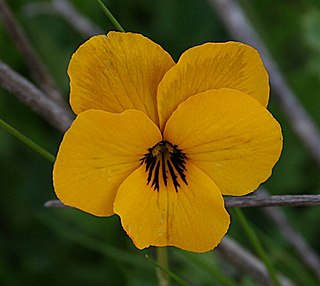
Viola pedunculata, the California golden violet, Johnny jump up, or yellow pansy, is a perennial yellow wildflower of the coast and coastal ranges in California and northwestern Baja California. The common name "Johnny jump up" is usually associated with Viola tricolor however, the introduced garden annual.

Salvia mellifera is a small, highly aromatic, evergreen shrub of the genus Salvia native to California, and Baja California, Mexico. It is common in the coastal sage scrub of Southern California and northern Baja California. Black sage has a dark appearance, especially during drought.

Coreopsis gigantea, known by the common name giant coreopsis, is a woody perennial plant native to coastal regions of central and southern California and also to northern Baja California.

Dendromecon rigida, also called bush poppy or tree poppy, is a shrub or small tree of the Papaveraceae native to California and Baja California.

Coastal sage scrub, also known as coastal scrub, CSS, or soft chaparral, is a low scrubland plant community of the California coastal sage and chaparral subecoregion, found in coastal California and northwestern coastal Baja California. It is within the California chaparral and woodlands ecoregion, of the Mediterranean forests, woodlands, and scrub biome.
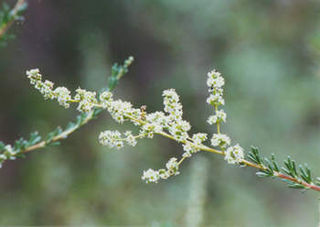
Adenostoma fasciculatum, commonly known as chamise or greasewood, is a flowering plant native to California and Baja California. This shrub is one of the most widespread plants of the California chaparral ecoregion. Chamise produces a specialized lignotuber underground and at the base of the stem, known as a burl, that allow it to resprout after fire has off burned its stems. It is noted for its greasy, resinous foliage, and its status as one of California's most iconic chaparral shrubs.
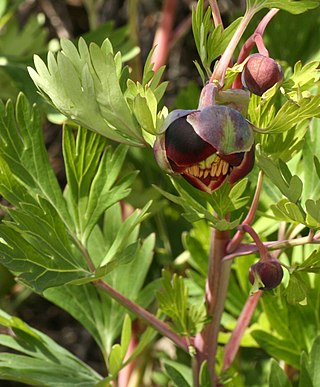
Paeonia californica is a perennial herbaceous plant of 35–70 cm high, that retreats underground in summer, and reoccurs with the arrival of the winter rains. It has lobed leaves, elliptic (cup-shaped) drooping flowers with dark maroon-colored petals, and many yellow anthers. It flowers mostly from January to March, and later develops two to five fruits per flower. Its common name is California peony and it is sometimes also referred to as wild peony. This peony is an endemic of southwestern California (USA), where it is not rare, and northernmost Baja California (Mexico). It grows on dry hillsides in the coastal sage scrub and chaparral communities of the coastal mountains of Southern and Central California, often as an understory plant.
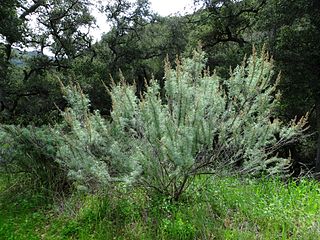
Artemisia californica, also known as California sagebrush, is a species of western North American shrub in the sunflower family.

Rhus integrifolia, also known as lemonade sumac, lemonade berry, or lemonadeberry, is a shrub to small tree. It is native to the Transverse and Peninsular Ranges and the South Coast regions of Southern California. This extends from Santa Barbara County and the Channel Islands to San Diego County and extending into north-central Pacific coastal Baja California and its offshore islands such as Cedros Island.

Rhus ovata, commonly known as sugar bush or sugar sumac, is a shrub or small tree found growing in the canyons and slopes of the chaparral and related ecosystems in Southern California, Arizona, Baja California and Baja California Sur. It is a long lived-plant, up to 100 years, and has dense evergreen foliage that make it conspicuous. It is closely related to and hybridizes with the lemonade sumac.

Baccharis pilularis, called coyote brush, chaparral broom, and bush baccharis, is a shrub in the family Asteraceae native to California, Oregon, Washington, and Baja California. There are reports of isolated populations in New Mexico, most likely introduced.
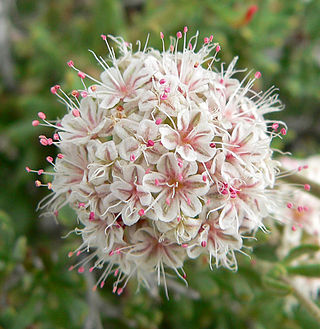
Eriogonum fasciculatum is a species of wild buckwheat known by the common names California buckwheat and flat-topped buckwheat. Characterized by small, white and pink flower clusters that give off a cottony effect, this species grows variably from a patchy mat to a wide shrub, with the flowers turning a rusty color after blooming. This plant is of great benefit across its various habitats, providing an important food resource for a diversity of insect and mammal species. It also provides numerous ecosystem services for humans, including erosion control, post-fire mitigation, increases in crop yields when planted in hedgerows, and high habitat restoration value.

Cochemiea dioica, also called the strawberry cactus, California fishhook cactus, strawberry pincushion or fishhook cactus, is a cactus species of the genus Cochemiea. Its common name in Spanish is biznaga llavina.

Lupinus bicolor is a species of lupine known as the miniature lupine, Lindley's annual lupine, pigmy-leaved lupine, or bicolor lupine.

Asclepias californica is a species of milkweed known by the common name California milkweed. It grows throughout lower northern, central and southern California.
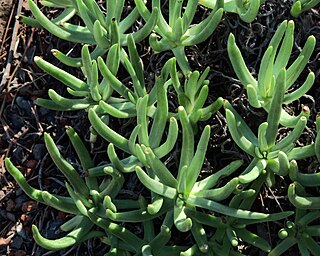
Dudleya edulis is a species of perennial, succulent flowering plant of the Crassulaceae, known by the common names fingertips, lady-fingers, mission lettuce, or simply the San Diego dudleya. The common name "fingertips" denotes the finger-like shape of the leaves; the specific epithet edulis refers to the Kumeyaay people's traditional foraging and consumption of the plant's young scapes. Dudleya edulis is native to the dry, coastal cliffs and chaparral hills of Southern California and northern Baja California, where it has adapted to absorb as much moisture as possible from the nightly fog and marine layer which forms over the Pacific Ocean and gradually moves slightly inland, typically covering all plants and stationary objects in dew. In addition to its inherent drought-tolerance and xeric qualities, this species is also highly salt-tolerant, as it grows almost exclusively facing the ocean, often in exposed settings where it is subjected to regular periods of extreme wind and weather. The species may be found growing on rocky hillsides, sandstone sea cliffs, chaparral habitat, arid canyons, or rooted between exposed, bare rock crevices.
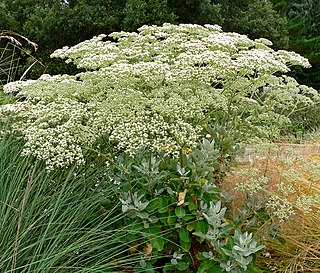
Eriogonum giganteum, with the common name St. Catherine's lace, is a species of wild buckwheat in Southern California.
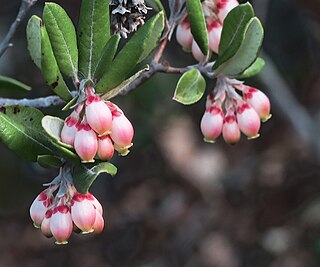
Xylococcus is a monotypic genus of flowering plants in the heather family which contains the single species Xylococcus bicolor, commonly known as the mission manzanita. It is a burl-forming, evergreen shrub with leathery leaves and smooth dark reddish bark. From December to February, white to pink urn-shaped flowers adorn the foliage, often attracting hummingbird pollinators. It is native to southern California and the Baja California Peninsula, south to the Sierra de la Giganta. There is growing concern over the future of this plant, referred to as the "queen of the elfin forest, " as it may possibly lose up to 88% of its habitat and its wild seedlings are failing to survive more than a full year.

Lepidospartum squamatum is a species of flowering shrub in the daisy family known by the common names California broomsage and scale broom.

Rhamnus crocea subsp. ilicifolia, synonym Rhamnus ilicifolia, is a subspecies of flowering plant in the buckthorn family, known by the common name hollyleaf redberry. It is native to western North America, where it is a common plant growing in many types of habitat, including chaparral and wooded areas, from Oregon through California, to Baja California and Arizona.




















